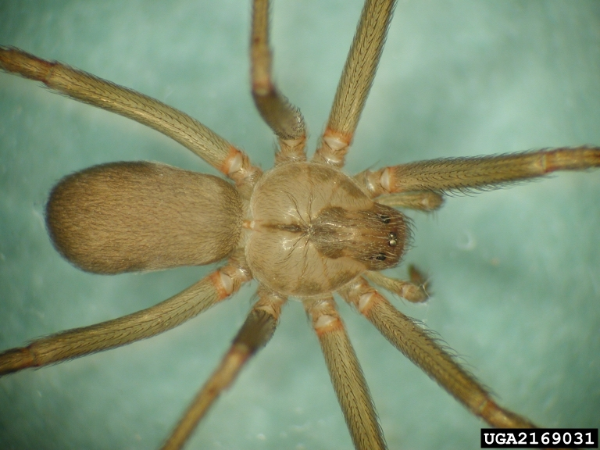
Brown Recluse
May 19, 2025 - Sarah Hughson
The brown recluse spider (Loxosceles reclusa) lives up to its name. It is a small, brown spider that tends to hide from humans. The brown recluse gain a lot of attention from the media because of health concerns resulting from its bite. While there have been many news stories about brown recluse spiders over the years, very few people encounter them in Michigan and they rarely bite people.
Brown recluse spiders are small, about 9 mm from head to rear end with long legs. the main identifying characteristic of this spider is the dark brown violin shaped marking on its cephalothorax (the main portion of the spider body that is essentially a fused head and thorax). The wide end of the violin shape is toward the front of the cephalothorax near the eyes and the slender end of the violin (bridge) extends toward the rear of the cephalothorax. The brown recluse also has six eyes.
In nature, brown recluse spiders live in small gaps under rocks, in wood piles and under bark. In buildings, they prefer warm, dry locations with small crevices to hide. Some common locations include cracks in walls, storage areas, boxes and stacks of papers or newspapers. Because of this behavior, people don't always come into contact with the spiders even though they share a living space. These spiders do not seek people out to bite them and bites are rare even in homes with many spiders. Bites usually occur when a spider is accidentally handled or if it is caught in a piece of clothing and pressed against the body.
Most people are concerned about brown recluse spiders because of the health risks resulting from their bite. Brown recluse bites can cause necrotic lesions on the skin but this is rare. Most (about 90%) brown recluse bites result in no reaction or a small reaction on the skin that resolves on its own. Those who do have a reaction to the bite should have the wound evaluated by a medical professional. The yellow sac spider is a native spider that is common in homes and can cause similar skin lesions to a brown recluse. Like the brown recluse, many people who are bitten by the yellow sac spider do not have a reaction. Without identifying the spider that caused the bite, it can be difficult or impossible to know which species caused the issue.
Michigan is not within the native range of the brown recluse, but there are a few small, isolated populations in the state. Brown recluse spiders did not travel to Michigan on their own, they were accidentally transported by people. Because brown recluse often hide in papers and boxes, they are easily transported to new locations when people move or haul goods. Brown recluse spiders have been found in Genesee, Hillsdale, Ingham, Kent, Lenawee, Livingston, Oakland, Shiawassee, Washtenaw and Wayne counties.
After confirming the spiders in the home are brown recluse spiders by emailing a photo (MSUBugHelp@msu.edu) or sending a sample to Plant & Pest Diagnostics, some clients choose to hire a professional pest control professional to manage the difficulties and health risks of brown recluse control. Management for brown recluse and other spiders can be challenging. Because they hide in tight crevices, brown recluse spiders can be difficult to locate and pesticide applications may not reach them. Pest control professionals should use an integrated pest management plan with multiple control methods to manage brown recluse spiders. This may involve monitoring population changes using sticky traps, sealing cracks to limit access to hiding places, applying pesticides to control spiders, and controlling the insects the spiders feed on. Pest control professionals may also encourage residents to declutter spaces to reduce brown recluse habitat in the home.
Resources:
MSU Extension. Haward Russell. 2018. Don't panic over brown recluse spiders in Michigan.
PennState Extension. Steve Jacobs. 2022. Brown recluse spiders.
Alabama A&M Extension. Xing Ping Hu. 2022. The brown recluse spider: facts & control.



 Print
Print Email
Email





